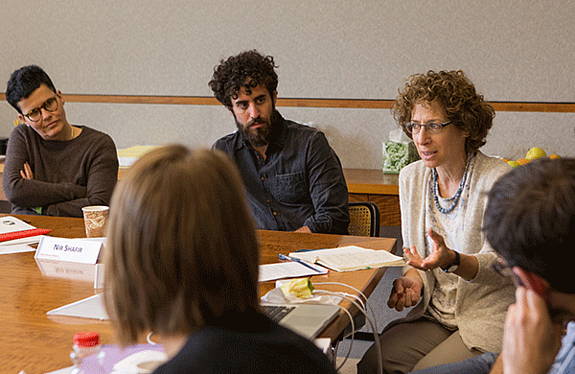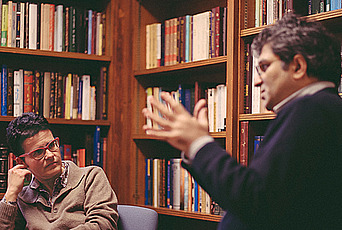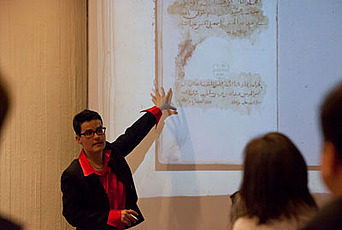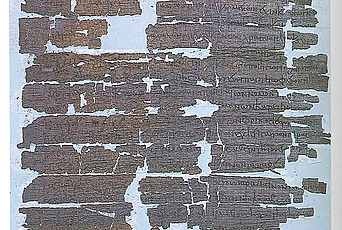Designing the Digital Ottoman Project

What makes a digital Ottoman project different from other digital projects and why isn’t it a straightforward endeavor but rather one that will probably take several years to develop successfully? And why isn’t there one already? Why would twenty-four people need one week together even to figure out where to begin? The Digital Ottoman Platform (DOP) workshop convened at the Institute June 8–12, 2015, to establish a transnational digital space in which to create, collect, and manage source materials, datasets, and scholarly work related to the Ottoman world. The goal is that these resources will be transparently and reliably authored, referenced, and reviewed to ensure that scholarly standards of research and publication are maintained for materials created and made available. The site, its materials, and its datasets will be sustainably managed to serve the global community of scholars, many of whom will also have contributed to the platform from their own research. At the same time, the space will be accessible to students, researchers, and readers worldwide.
Our vision is that the DOP will make it possible to locate and share resources and results in original, intermediate, and published formats and to create new collaborations for research and learning. It also aims to identify and document best practices among the dynamically developing digital technologies that now enrich the tools and methodologies of the humanities. Although these efforts focus specifically on Ottoman history, they may well create models for other fields of study or enterprises facing similar challenges.
A brief perspective on Ottoman studies and the ex-Ottoman lands makes clear the scope of the challenge and also emphasizes why the DOP could play a leading role in expanding the digital capacities not only of Ottoman studies but of Islamic and Near Eastern studies generally.
Ottoman history is narrowly defined by the six hundred years of Ottoman dynastic rule over a single entity (that grew and shrank), yet builds more broadly on legacies inherited in the lands conquered by the Ottomans; the Empire also left legacies with direct implications for the history of the ex-Ottoman lands even today. Addressing the largest Muslim state from the sixteenth to the twentieth century, Ottoman history is also integral to the study of Islamic thought and practice. The Ottoman Empire included a geography that today encompasses some twenty-five to thirty countries, including Anatolia, large portions of the Arab world, the Balkans and eastern Europe, the Crimea, the Caucasus, and western Iran. Scholars working on Ottoman history use original written sources in at least twenty-five languages that engage at least eight separate alphabets. Added to the written literary and documentary sources is a vast array of architectural, pictorial, numismatic, textile, metal, wood, and other evidence.
Obviously, no single person has the skills to work with this diversity of sources. Thus scholars of the Ottoman empire will benefit exponentially if systems and methods can be created for sharing not only the results of their separate research but also for collaborating on projects that demand a multiplicity of sources and methods, and for making available source materials in primary or intermediate formats for comparative projects. Sharing and collaboration of this kind necessarily (but not always easily) occurs across geographic distances, political divides, and language barriers. Some of these are more daunting or intractable than in many other fields of research. If successful, this digital platform will facilitate new kinds of research and communication, while making scholars of the Ottoman empire generally more efficient and effective in their work.
The workshop was sponsored by Sabine Schmidtke, Professor in the School of Historical Studies, and convened together with me, along with Chris Gratien (Yale), Michael Polczynski (Georgetown), and Nir Shafir (UCLA), who have each worked on a digital resource for Ottoman history and were together the authors of “Digital Frontiers of Ottoman Studies,” Journal of the Ottoman and Turkish Studies Association 1, no. 1–2 (2014): 37–51. A further nineteen participants from the United States, Canada, Britain, Germany, Greece, Bulgaria, and Turkey included scholars of pre-Ottoman and Ottoman history, librarians with digital expertise, geographers specializing in historical GIS projects, and an engineer with extensive management experience and digital skills.
Participants shared their knowledge of existing digital resources for Ottoman studies: programs, databases, published research, pedagogical materials, and research tools for scholars. These include, for example, databases on Ottoman historians and inscriptions from Ottoman buildings; books and original manuscripts from library collections worldwide; the Ottoman History Podcast (ottomanhistorypodcast.com) with some two hundred episodes; Hazine, a research guide; online catalogues to archives; costly and rare dictionaries online; and published scholarly work (out of copyright).
Individual presentations of hands-on experience with different digital methodologies and technologies fostered discussions of the advantages and challenges of digital endeavors in the humanities. Each contributed a valuable perspective on what is required to design, initiate, manage, fund, scale up, and sustain a project of the magnitude we envisage. The workshop emphasized to all of its participants that digital projects such as this can only thrive as partnerships of skills, enthusiasm, professional standards, and material support. At the same time, the discussions also considered carefully how and why digital projects falter or fail. Workshop participants shared their own experiences, frustrations, and critiques, examining carefully past projects and those currently under way.
Declining or absent human or financial resources, technologies that became obsolete, and uncertain goals are only a few of the persistent problems that have undermined promising initiatives. Successful projects must address specific needs and be critically evaluated and tested on a small scale before committing extensive resources to them. As a result, the DOP is proceeding deliberately and with caution.
The collective decision to emerge from the workshop was that a gazetteer of the Ottoman lands will constitute the greatest contribution to the largest number of scholars. It will be a geo-referenced catalogue of places, each to be listed with its various names, in several languages, in their original alphabets and transliterated to Latin characters. Every entry and its variants will include dated references to its sources, and contributions will be reviewed before uploading, to make the gazetteer a reliable scholarly resource. From a practical perspective, the gazetteer can grow in a modular fashion, incorporating contributions as they are submitted. While it builds on the existing models from other fields, many Ottoman-specific challenges will need to be resolved. Of relevance far beyond the field of Ottoman studies is the larger challenge of how to ensure that the contributing authors of the gazetteer receive adequate academic credit for the critical scholarship needed to create sound data.
We envisage that the DOP will not only create datasets (gazetteer, biographies, monuments). It will also link to (and be interoperable with) robust digital projects (that pass a scientific review); provide a reference source for tested digital tools; incubate new projects; and serve as a digital publication site. The DOP will thus create basic resources for the entire field and exemplify how best to engage digital capabilities for humanistic research.
The DOP project fits as a natural complement to the ongoing projects in the IAS School of Historical Studies that engage digital capabilities in their research. In the specific context of the DOP, Schmidtke will focus on the creation of a Yemen Historical GIS as a complement to her ongoing studies of Yemeni manuscripts and scholarship. We believe that the IAS can play a unique role in this project, providing the ideal environment in which to define and nurture its successive phases. A local by-product of the seminar is the plan by the HS–SS Library to hold a series of workshops offering Members in both Schools the opportunity to explore and apply the digital tools that are expanding the parameters of scholarly inquiry. As the DOP workshop clarified, these tools work best when deployed by historian/social scientist–librarian–technologist teams, each bringing professional experience and a refined skill set to the endeavor.


